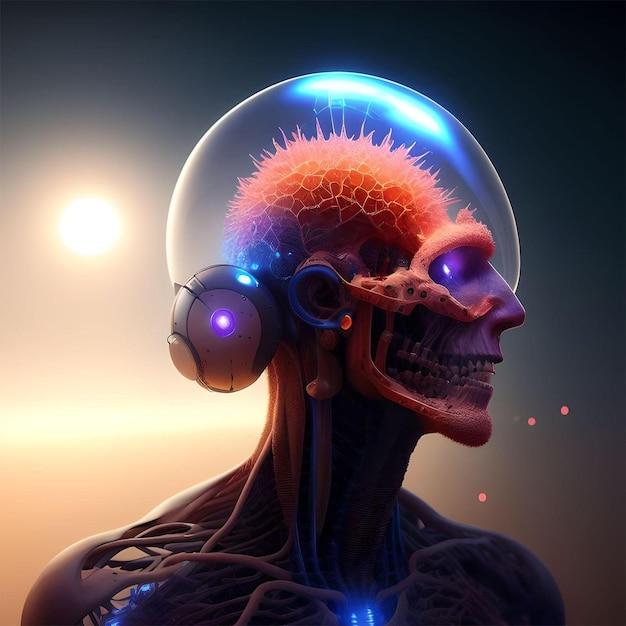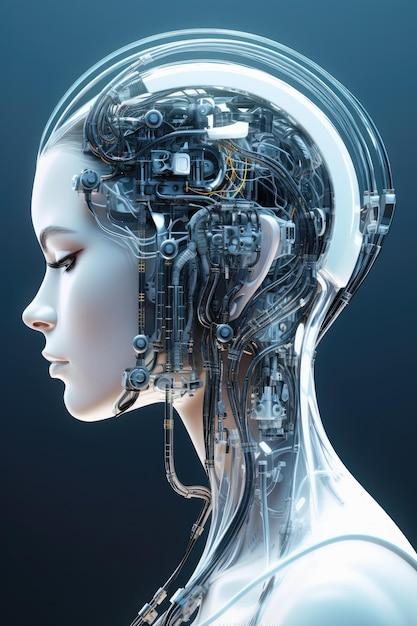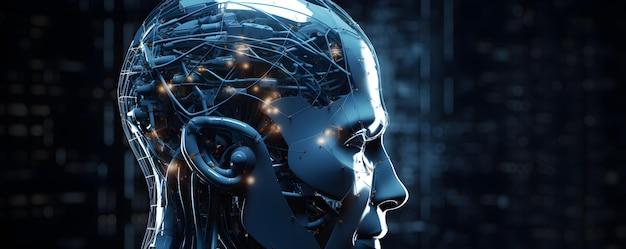The world is constantly changing, and the advancements in technology seem to be accelerating at an unprecedented rate. One of the most disruptive technologies that has recently captured the imagination of people is Neuralink. Developed by the technology industry’s most daring visionary, Elon Musk, Neuralink is a brain-computer interface that has the potential to revolutionize the way we interact with technology.
This breakthrough technology aims to provide an unprecedented level of integration between the human brain and advanced computer systems. It is believed that Neuralink can increase cognitive abilities, treat neurological disorders, and even increase lifespan. However, since there hasn’t been a collection of unbiased studies and reports, there are concerns about the safety and ethical implications of this technology.
In this blog post, we will attempt to evaluate Neuralink’s performance as a technological innovation and consider its implications for society. We will investigate its potential advantages and disadvantages, if any, and assess the viability of its touted promises. Furthermore, we will analyze whether the technological breakthrough is worth the potential risks and whether its advantages outweigh the disadvantages.
Neuralink is a prime example of how emerging technologies can shape our future. Its potential impact on society, especially in the fields of healthcare and technology, is immense. Join us as we delve into the world of Neuralink, exploring its capabilities, its strengths, and its potential weaknesses. Let’s discover together whether it is a technological promise that will change the world for better or is a potentially dangerous experiment that needs to be approached with caution.
Is Neuralink Technology Safe
When it comes to cutting-edge technology like Neuralink, it’s natural to have concerns about safety. After all, implanting a device into the human brain is no small feat! So, let’s explore the safety concerns surrounding Neuralink and see if there’s anything to worry about.
The Safety Record of Brain Implants
Neuralink’s technology is not the first brain implant that has been developed, so there is already a safety record to consider. Here are some key takeaways:
- Brain implants have been used successfully in thousands of patients to treat conditions like epilepsy, Parkinson’s disease, and chronic pain.
- Like any medical intervention, there are risks and potential complications associated with the implantation of brain devices, such as infection, bleeding, or damage to surrounding tissue. However, these risks are generally low, and most patients do not experience significant side effects.
- The safety of any brain implant ultimately depends on the expertise of the surgeon performing the procedure and the quality of the device being implanted.
Neuralink’s Safety Measures
Neuralink is serious about safety and has implemented several measures to ensure the safety of their technology:
- Before any implantation procedure, the patient undergoes a full medical workup to assess their health and the risks associated with the procedure.
- Neuralink’s device is designed to be minimally invasive, which means that the implantation procedure is less risky than other brain implants that require more extensive surgery.
- The device is made from biocompatible materials that are unlikely to cause an immune reaction or other adverse effects in the body.
- Neuralink has partnered with top neuroscientists and engineers to ensure that their technology is of the highest quality and safety standards.
Based on the safety record of brain implants and Neuralink’s safety measures, there is no reason to believe that Neuralink’s technology is any less safe than other brain implants currently in use. Like any medical intervention, there are risks involved, but the benefits of this technology could be life-changing for patients with conditions like paralysis, Alzheimer’s disease, or spinal cord injuries.
Dangers of Neuralink
While the Neuralink technology offers many promises, it also comes with a set of potential dangers that are worth considering. Some of the most pressing concerns are:
1. Privacy invasion
Neuralink intends to implant small chips into people’s brains, which can potentially access personal information about the individual, such as their thoughts, feelings, and memories. This raises the question of how securely this information will be stored and who will have access to it.
2. Hacking
Like any electronic device, the Neuralink chip is vulnerable to hacking. Hackers could potentially hijack the chip and gain control over the individual’s brain, which could lead to disastrous consequences.
3. Addiction
With the ability to directly stimulate pleasure centers in the brain, there is a risk that individuals could become addicted to the Neuralink chip and constantly seek out the stimulation it provides. This could lead to a loss of control and potentially harmful behavior.
4. Dependence
As the Neuralink chip becomes more integrated into society and widely available, there is a risk that it could become a necessity for certain individuals. This dependence could lead to a loss of free will and autonomy.
5. Inequality
If the Neuralink technology becomes available only to the wealthy and privileged, it could further widen the gap between the rich and poor. This could lead to increased social unrest and division.
While these concerns are valid and must be taken seriously, it is important to note that they are speculative. There is still much that we do not know about the potential dangers of Neuralink, and further research is needed to better understand the risks and benefits of this technology. Ultimately, it is up to society as a whole to carefully consider the implications of Neuralink and make informed decisions about its use.
Neuralink and Immortality
As technology keeps advancing at a breakneck pace, it’s only a matter of time before we see some groundbreaking developments regarding human longevity. Neuralink, one of the most exciting and promising ventures of our time, is uniquely positioned to play a significant role in this domain. Here are some key points to consider about Neuralink, immortality, and the possibilities that lie ahead.
Could Neuralink Make Us Immortal
The idea of immortality has fascinated humanity for centuries. From vampires to Greek gods, various cultures have posited different theories about how we could achieve eternal life. While we still haven’t figured out how to cheat death entirely, Neuralink could open up entirely new avenues for extending life as we know it.
Here’s how:
- Neuralink is a brain-computer interface (BCI) company founded by Elon Musk that aims to merge humans with artificial intelligence (AI). Their technology allows us to control computers and other devices with our thoughts.
- By linking our brains directly to computers, Neuralink could potentially mitigate age-related cognitive decline and degenerative diseases such as Alzheimer’s. This means that we could live longer and healthier lives.
- Even more intriguingly, Neuralink’s BCI could allow us to upload our consciousness to a computer the same way we upload files to the cloud. In theory, this could make us “immortal” by preserving our minds beyond the lifespan of our physical bodies.
What are the Implications of Immortality
While the idea of immortality might sound appealing to some, it raises a host of existential and practical questions.
Here are some key implications to consider:
- If we could upload our consciousness to a computer, what does this mean for our sense of self and identity? Would we still be “us” if we’re no longer tied to our physical bodies?
- How would this technology impact concepts such as death, bereavement, and mourning? Would we still grieve the loss of loved ones the same way if we know that they’re still “alive” in some form?
- The implications of immortality extend beyond philosophical or ethical debates. It could also have significant implications for society, from population control to workforce dynamics.
While the idea of immortality sounds like science fiction, Neuralink’s technology could be a game-changer that shapes the future of humanity. Whether we’ll achieve true immortality remains to be seen, but the possibilities are tantalizing. As we continue to explore the implications and possibilities of Neuralink, we may find ourselves on the precipice of a new era of human consciousness and longevity.
Neuralink Implications: What Could Happen
Neuralink is a company that aims to connect the human brain with the internet. The implications of this technology are vast and could change the way humans interact with the world. Here are some possible implications of Neuralink:
Health and Medicine
- Neuralink could be particularly helpful in treating brain disorders such as Parkinson’s, Alzheimer’s, and epilepsy.
- The technology could also provide insight into how the brain functions, leading to new treatments for mental health conditions such as depression and anxiety.
Lifestyle Changes
- The ability to control devices with our thoughts could make everyday tasks much more accessible, particularly for those with physical disabilities.
- Neuralink could also create a new form of entertainment, with virtual reality experiences designed to engage the brain directly, giving users a more immersive experience.
Privacy and Security
- There are concerns about confidentiality and the protection of sensitive information regarding the implantation of a Neuralink device into individuals’ brains.
- Such devices pose significant security threats as they connect individuals directly to the internet, raising fears of hacking and privacy concerns.
Ethical Considerations
- There is a range of ethical concerns that could arise from the use of Neuralink technology, including questions about the freedom of the mind and the potential social inequalities it could create.
- There is also the concern that this technology could exacerbate the divide between the rich and the poor, giving those who can afford it an unfair advantage over the underprivileged.
In conclusion, the potential impact of Neuralink on society is vast, and the implications outlined above only scratch the surface. It remains to be seen how individuals and society as a whole will navigate this technology’s challenges and opportunities.
Is Neuralink a Good Idea
Elon Musk’s Neuralink Corporation, with its mission to advance brain-machine interface technology, has caused quite a stir in the tech world and beyond. While the idea of “merging” humans with machines using implanted brain chips sounds like something straight out of a sci-fi movie, it is becoming increasingly apparent that it could become a reality sooner than we think. But is this a good thing? Let’s explore some of the arguments for and against Neuralink.
Pros:
- Potential to cure neurological disorders: Neuralink’s technology could offer relief to millions of people who suffer from neurological disorders such as Parkinson’s and Alzheimer’s.
- Improved human capabilities: Brain implants could allow humans to access and process information at superhuman speeds, leading to improved problem-solving and decision-making abilities.
- Revolutionary changes to education: With brain chips, we could potentially learn new languages, subjects, and skills in a matter of seconds.
Cons:
- Ethics and safety concerns: There are significant privacy concerns when it comes to such an invasive technology. Questions arise about data privacy, ownership, and control.
- The digital divide: Not everyone will have access to this technology, which raises concerns about inequality and classism. The rich will become even more privileged, while the poor will be left behind.
- Unforeseeable consequences: We have seen in the past that introducing new technologies can lead to unforeseeable ramifications. What if the implanted devices had negative effects on people’s health or even behavior?
Takeaway
While the benefits of Neuralink are tempting and exciting, we must approach this technology with a critical eye and consider the potential negative implications. Before we rush to embrace this technology, we must consider the ethical, social, and legal implications that come with it. Whether Neuralink is a good idea or not remains to be seen, but one thing is for sure: it will undoubtedly change our world as we know it.
What are the Benefits of Neuralink
The Neuralink technology, which is a brain-computer interface developed by Elon Musk, is one of the most exciting inventions of recent years. While many people might be apprehensive about the introduction of a new technology that directly connects the human brain to computers, there are several benefits that we can expect from Neuralink. Here are some of the benefits that the technology can bring:
1. Treatment of Neurological Disorders
One of the most significant benefits of Neuralink is its potential to help people with neurological disorders. The technology can help in the treatment of diseases such as Parkinson’s, Alzheimer’s, and epilepsy by providing accurate and timely monitoring of brain activity and delivering targeted therapies to specific areas of the brain.
2. Enhancing Brain Function
Neuralink has the potential to enhance brain function and cognitive abilities. By directly connecting the brain to computers, Neuralink can help individuals to learn faster, memorize better, and process information more efficiently. Additionally, it can enable people to communicate and control devices using their thoughts, which can have significant benefits for people with physical disabilities.
3. Increased Efficiency and Accuracy
Neuralink can help in the creation of more efficient and accurate brain-computer interfaces. This can allow for faster and more accurate data processing and communication, leading to a more significant impact on various industries, such as healthcare, education, and entertainment.
4. Advancements in Scientific Research
Neuralink can also have a significant impact on scientific research. The technology can provide a new understanding of how the brain works, its structure, and functions. Additionally, it can help in the creation of more accurate models to test drugs and therapies, leading to faster and more efficient development of treatments for various neurological disorders.
5. Increased Productivity
Neuralink can enhance workplace productivity by enabling employees to work more effectively and efficiently. With the help of the technology, companies can automate repetitive tasks, such as data entry, and provide employees with enhanced tools and methods to complete their work more productively and accurately.
In conclusion, the Neuralink technology has vast potential to bring several benefits to society. As with all new technologies, it is essential to be cautious and ensure that the technology is ethically implemented. Nonetheless, we can expect Neuralink to have a positive impact on several aspects of our lives.
How Neuralink Will Change the World
Neuralink, the brain-machine interface startup launched by Elon Musk, has the potential to revolutionize the way we interact with technology. Here’s how Neuralink could change the world:
1. Enhanced Human Capabilities
With Neuralink’s implantable brain-machine interfaces, humans could enhance their cognitive abilities, memory, and overall brain function. This could lead to a society of “superhumans” with enhanced productivity, creativity, and problem-solving skills.
2. Futuristic Prosthetics
Neuralink’s technology could also lead to the development of futuristic prosthetics that can be controlled by the brain. These prosthetics could give amputees and people with disabilities the ability to move and function like able-bodied individuals.
3. Improved Communication
Neuralink’s brain-machine interfaces could also improve communication by allowing people to transmit thoughts, ideas, and emotions directly to each other. This could revolutionize the way we communicate and eliminate language barriers.
4. New Forms of Entertainment
With the ability to transmit thoughts and emotions directly to each other, Neuralink’s technology could also lead to new forms of entertainment, such as immersive virtual reality experiences that mimic real-life experiences.
5. Breakthroughs in Neuroscience
Neuralink’s research could lead to breakthroughs in neuroscience, enabling us to learn more about the brain and how it works. This knowledge could lead to new treatments for neurological disorders, such as Alzheimer’s and Parkinson’s disease.
6. Improved AI
Neuralink’s brain-machine interfaces could also lead to improvements in AI technology. By mimicking the neural pathways in the brain, AI could become more human-like in its thought processes and decision-making abilities.
Neuralink has the potential to change the world in countless ways. While there are certainly concerns about privacy, security, and the ethical implications of such technology, the future looks exciting and full of possibilities.
Advantages and Disadvantages of Neuralink
Neuralink, the brain-machine interface company co-founded by Elon Musk, has been making headlines since its inception. The company aims to provide seamless communication between the human brain and computers, enabling humans to control devices with just their thoughts. While the technology holds immense potential, there are also concerns around its impact on society. In this section, we will discuss both the advantages and disadvantages of Neuralink.
Advantages
- Improved medical treatments: Neuralink could revolutionize the field of medicine by helping individuals with brain injuries, neurological disorders, and other health conditions. The technology could enable doctors to monitor patients in real-time, making treatment more effective.
- Enhanced quality of life: The ability to control devices using your mind could enhance the quality of life for individuals with disabilities, helping them to interact with the world around them and perform everyday tasks.
- Increased efficiency: Neuralink could improve workplace efficiency by allowing individuals to work faster and more precisely. Also, the ability to manipulate devices without physical contact could reduce the need for physical maintenance, making industrial work safer.
- Opens up new possibilities: Neuralink could create new possibilities in gaming, education, and entertainment. The technology could enable gamers to control characters in games directly with their thoughts, and also could allow individuals to learn new skills through direct brain-to-brain communication.
Disadvantages
- Security threats: The technology could be vulnerable to hacking, leading to the invasion of personal privacy and data breaches. Hackers could potentially extract critical personal information about an individual through the device.
- Social inequality: The introduction of Neuralink could lead to greater inequality, with only the wealthy being able to afford this technology, thus creating a technological class divide between individuals.
- Invasive: The technology entails brain surgery, and even though minimal, it poses risks of infection, brain damage, or paralysis in worst-case scenarios. Moreover, people may feel uncomfortable with an implant within their heads.
- Dependence: Extensive use of Neuralink could lead to individuals becoming heavily reliant on technology, with the potential for addiction forming over time.
In conclusion, Neuralink holds significant promise for humanity, provided that adequate measures are put in place to address the concerns surrounding the technology. It is our responsibility to weigh the advantages and disadvantages of using Neuralink to improve our lives and ensure that we make informed decisions about its adoption.



